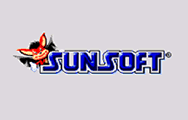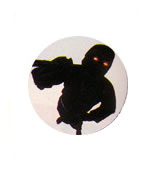It’s not often that I get to interview someone who’s not only had a hand in making Genesis games but also in the beginnings of American gaming journalism. Those who played games during the early ’90s definitely remember Electronic Gaming Monthly’s “Review Crew,” a group of devoted gamers that reviewed every single cart that came their way, good or bad. As maybe the most recognizable face of EGM, though his face was never actually revealed, was Sushi-X. A hardcore fighting game fanatic who hated everything Game Boy, the character was actually created and developed by David Siller, who left EGM in 1992 for a career in game development at Sunsoft.
 While he was there, Siller handled the SNES development of the famous Looney Tune franchise and he created Aero the Acrobat and its spin-off Zero the Kamakaze Squirrel. After a long tenure at Sunsoft, Siller moved on to Universal Interactive as a producer for Crash Bandicoot and then to Capcom, where he served as producer and designer for Maximo: Ghosts to Glory. Today, Siller is a part of Throwback Entertainment, a company founded in 2004 that owns the rights to many of Acclaim’s former franchises, like Re-Volt and Legends of Wrestling.
While he was there, Siller handled the SNES development of the famous Looney Tune franchise and he created Aero the Acrobat and its spin-off Zero the Kamakaze Squirrel. After a long tenure at Sunsoft, Siller moved on to Universal Interactive as a producer for Crash Bandicoot and then to Capcom, where he served as producer and designer for Maximo: Ghosts to Glory. Today, Siller is a part of Throwback Entertainment, a company founded in 2004 that owns the rights to many of Acclaim’s former franchises, like Re-Volt and Legends of Wrestling.
Always eager to talk to Genesis game makers, Sega-16 was lucky enough to speak with Mr. Siller about his time at Sunsoft and his experiences with Sega’s wonderful console.
Sega-16: You were the original Sushi-X at Electronic Gaming Monthly back in the early ’90s. The magazine hadn’t yet evolved into the print juggernaut that it’s become. What was it like working there back during the 16-bit era?
David Siller: It was a very difficult time because I was doing so many things to stay afloat. I was selling ad space for the magazine, traveling on their behalf to shows in the U.S. and Japan, writing articles and reviews and was also involved in a start-up coin-op development company with my brother Ron and the Bundra brothers from Konami, Frank and Joey. The magazine was late often and I was the only one to answer calls from angry subscribers and advertisers who wanted to know where the latest issue was! Gamepro was a major competitor and their ad rep, Jeff Eisenburg, was burying us in rumor and innuendo. Once the magazine got stronger due to faithful readership following our Review Crew and International coverage, that very same Sales Rep from GP was hired to replace me, right when things were finally looking up and I thought that I could finally make a decent living!
I created several identities, such as Terry Akki and Sam Morri, to offer up news and information because I had many ties within the industry. I also suggested to the publisher that we need to offer a review section because consumers need guidance when considering expensive game purchases, which became the “Review Crew.” The publisher hated the idea but later agreed, so it was done. Working with Ed Semrad and Martin Alessi was great as were others there at that time. The publisher had always offered that when things were better or the company was sold that I would benefit, but that of course never happened.
Sega-16: When did you start at Sunsoft? What was it like?
David Siller: I was hired in January 1990 and had just come off of an arcade game project working for a small company. I had been a consultant for the previous Director of Development, so they figured that I might be a good fit for them as I was familiar with their products.
Sunsoft was a great experience when I went there and was hired by their President Joe Robbins on the recommendation of Rita Zimmerer, who was their VP of Sales and Marketing. Joe was a legend in the arcade coin-op business and was a no-nonsense kind of guy. He was quite a character, and he and Rita were great at empowering me to be aggressive in the design and planning of their product line. The Japanese parent company was also great, and on my first trip to Japan for them I met Mr. Maeda who told me to stick around a while. He and Mr. Yoshida, the head of global development, were also very good to me and made me feel welcomed and important to the company. For this I rolled up my shelves and got to work designing and planning products based on the various licenses they had.
Sega-16: Sunsoft was a major publisher during the NES era, and it seemed to remain strong during the life span of the Genesis; however, the company seemed to just disappear with the transition to 32-bit hardware (along
with other companies like Data East). No one’s really clear about where it went. What exactly happened to Sunsoft?
David Siller: What essentially happened is that they replaced Joe Robbins with another gentleman, Tad Shimamoto who was more interested in a golf course venture in partnership with Mr. Maeda. He started channeling the Sunsoft resources into that venture in Palm Springs which was called “Desert Wells” (or dry hole). With the handwriting on the wall and other companies interested in my services, I left to join the fledging Universal Interactive Studios.
Sega-16: The Genesis has a history of great Disney games, like Castle of Illusion and Aladdin. Did you ever feel like you were under pressure to deliver a certain standard of game when using Disney licenses?
 David Siller: Yeah, but the pressure started with our own sense and desire to deliver quality. Our concept for Beauty & the Beast was held-up for four months because of Disney’s difficult staff that were only interested in the Virgin project being developed by Dave Perry’s team. That left us under the gun to complete that two-game project using an external developer and still make Christmas! Under those types of circumstances it is difficult to compete. Working with Disney’s licensing department was very painful to say the least.
David Siller: Yeah, but the pressure started with our own sense and desire to deliver quality. Our concept for Beauty & the Beast was held-up for four months because of Disney’s difficult staff that were only interested in the Virgin project being developed by Dave Perry’s team. That left us under the gun to complete that two-game project using an external developer and still make Christmas! Under those types of circumstances it is difficult to compete. Working with Disney’s licensing department was very painful to say the least.
Sega-16: Many consider Blaster Master 2 to have fallen short of the NES original, which is considered a classic. What is your assessment of the game?
David Siller: The problem was again too little development time, and we again had to cut too many corners thus eliminating creative content. The original game was a classic and ahead of its time, and it takes great care and clever creativity to compliment that game. Even if we had twice the development time and budget, we probably would have still fallen short. I still enjoy playing the original today, as I have an extensive Famicom collection.
Sega-16: Aero the Acrobat was immediately compared to Sonic The Hedgehog, which in a way, unfairly set a standard for Genesis platformers. Did it ever seem like you were competing with Sega’s hedgehog?
David Siller: Unfairly competing yes, because Aero was really nothing like Sonic in the way the game played. I feel that people were expecting that Aero was Sunsoft’s version of or answer to Sonic, but nothing could be further than the truth. Aero had its own unique gameplay and set new standards for how games played. Aero was the first game to offer missions that needed to be accomplished, rather than just getting from point “A” to point “B.” The player needed to do these mission tasks in order to activate the exit! Sonic and other games did not play that way. Sonic was indeed genius with its rapid running and puzzle structured playfields, but Aero did not emulate running fast and was a very different game altogether.
The greatest similarity between Aero and Sonic was that they were both built similar to the Mickey Mouse body structure that was and is still common in some cartoon characters type. There were even others of similar cartoon build that were marketed at that time! The big head – small body and long limbs were fun to work with and made for good gameplay attributes.
The idea for Aero the Acrobat was in my head years before he finally appeared again thanks to Joe Robbins and Rita Zimmerer. Joe Robbins even had a serious conversation with Mr. Nakayama who was the head of Sega at that time to make him an exclusive for the Sega console, but in the end the company decided that he was good enough to go multi-platform and be presented as the company’s mascot product.
Sega-16: The re-release of Aero the Acrobat appears to have done pretty well. Is there any chance we’ll ever see him or Zero again in a new game, perhaps a compilation?
David Siller: I have continued to prepare newer versions of the Aero & Zero game designs while working closely with Justin Siller who assisted in the creativity for them as well. It is my hope that Throwback Entertainment will finally bring new episodes of this IP to the market in the days ahead.
Sega-16: Why was Daze Before Christmas never released in America?
David Siller: The original idea for that game came from Rita Zimmerer, and she wanted a Christmas product for that annual season. I started designing a detailed concept with a twist on the whole Santa Claus story. That included disgruntled elves and a union like boss type known as “Louse the Mouse.” The game was intended to be different yet still cute and definitely action-orientated. The developer I chose was from Norway and very eager, but frankly the quality of their efforts were not up to what we wanted. Since we were already short-handed on other products, we decided to shelf that game so it was never released, at least in the US. Frankly, I am surprised that it was released anywhere else.
Sega-16: The Looney Tunes games you worked on were never released on the Genesis, which instead got its own set of exclusives with the license (Bugs Bunny in Double Trouble, the Taz games). Why were the SNES games never released on the Genesis?
David Siller: Sunsoft did not have the license or rights to develop any Looney Tunes games for the Genesis, only for the Super Nintendo. Those Genesis games were licensed by Sega themselves and they tried to copy our lead.
Sega-16: Given its late release, were there ever any plans to bring Scooby-Doo Mystery to the Sega CD or 32X? It seems like it would have been a perfect fit for the CD format.
David Siller: It would have made for a very nice CD game but was never discussed at that time.
Sega-16: As a veteran of the game industry, do you think there’s still a place on modern consoles for the platforming and action classics of the 16-bit era? Some franchises, like Super Mario Bros., have flourished, while others (Sonic, Castlevania) have struggled to adapt to a 3D world.
 David Siller: Yes, of course I do. It is all about creative vision and implementation of that vision. I believe that there is a lot yet to be presented and I am always eager for that chance. Platform games are a genre that is still well loved, but consumers are waiting for the next one that delivers a fresh approach that they can get addicted to! Not everyone who attempts it can be successful, as sometimes it appears to be easier than it is. Game players are always excited about any game that is fun to play and gets them well into the adventure therefore making a commitment to see it through.
David Siller: Yes, of course I do. It is all about creative vision and implementation of that vision. I believe that there is a lot yet to be presented and I am always eager for that chance. Platform games are a genre that is still well loved, but consumers are waiting for the next one that delivers a fresh approach that they can get addicted to! Not everyone who attempts it can be successful, as sometimes it appears to be easier than it is. Game players are always excited about any game that is fun to play and gets them well into the adventure therefore making a commitment to see it through.
Sega-16: Thank you for chatting with us!
David Siller: You’re very welcome! Thank you for the opportunity to discuss this.
Sega-16 appreciates Mr. Siller taking the time to chat with us. For more information on his current projects, be sure to check out the Throwback Entertainment website.

Pingback: Interview: René Boutin discusses Sunsoft, licensed games, and the 16-Bit era | Dromble
I’ve been going through all of the old interviews, reading them one-by-one. I’m impressed who you’ve been able to get, and the questions are well thought out. I hope this keeps up for years to come.